#react folder structure
Explore tagged Tumblr posts
Text
Mini React.js Tips #1 | Resources ✨
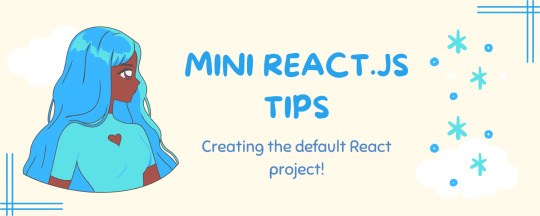
I thought why not share my React.js (JavaScript library) notes I made when I was studying! I will start from the very beginning with the basics and random notes I made along the way~!
Up first is what you'll need to know to start any basic simple React (+ Vite) project~! 💻
What you'll need:
node.js installed >> click
coding editor - I love Visual Studio Code >> click
basic knowledge of how to use the Terminal

What does the default React project look like?

Step-by-Step Guide
[ 1 ] Create a New Folder: The new folder on your computer e.g. in Desktop, Documents, wherever that will serve as the home for your entire React project.
[ 2 ] Open in your coding editor (will be using VSCode here): Launch Visual Studio Code and navigate to the newly created folder. I normally 'right-click > show more options > Open with Code' on the folder in the File Explorer (Windows).
[ 3 ] Access the Terminal: Open the integrated terminal in your coding editor. On VSCode, it's at the very top, and click 'New Terminal' and it should pop up at the bottom of the editor.


[ 4 ] Create the actual React project: Type the following command to initialize a new React project using Vite, a powerful build tool:
npm create vite@latest
[ 5 ] Name Your Project: Provide a name for your project when prompted.

[ 6 ] Select 'React' as the Framework: Navigate through the options using the arrow keys on your keyboard and choose 'React'.

[ 7 ] Choose JavaScript Variant: Opt for the 'JavaScript' variant when prompted. This is the programming language you'll be using for your React application.

[ 8 ] Navigate to Project Folder: Move into the newly created project folder using the following command:
cd [your project name]
[ 9 ] Install Dependencies: Execute the command below to install the necessary dependencies for your React project (it might take a while):
npm install

[ 10 ] Run the Development Server: Start your development server with the command (the 'Local' link):
npm run dev

[ 11 ] Preview Your Project: Open the link provided in your terminal in your web browser. You're now ready to witness your React project in action!


Congratulations! You've successfully created your first React default project! You can look around the project structure like the folders and files already created for you!
BroCode's 'React Full Course for Free' 2024 >> click
React Official Website >> click
Stay tuned for the other posts I will make on this series #mini react tips~!
#mini react tips#my resources#resources#codeblr#coding#progblr#programming#studyblr#studying#javascript#react.js#reactjs#coding tips#coding resources
116 notes
·
View notes
Note
OMGGG CAN YOU PLEASEEEEEE DO A CAITLYN X KINDA STONISH READER???I mean like reader isnt swayed by much she's straight postured and all that fancy stuff ykwim??? BUT cait is down BADDD. IDK IK IT'S KINDA WEIRD BUT PLEASE
CW: Mean? reader. Spitting, degrading, fingering. Both Caitlyn and reader are so kinky... yum

It began, as many things do in Piltover, within the walls of the Council chamber.
You're always there. Immaculate. Silent unless prompted—and even then, your words are chosen with such care and such discipline, it’s as though each syllable has been practiced before being offered aloud.
To Caitlyn, you never falter, never lean back in your seat, never shift in discomfort. Not even when Ambessa Medarda looks at you and you only when talking.
Your back remains straight. Your hands folded. And yet—somehow—Caitlyn knows you are not a passive observer. You are not aligned with Ambessa’s ruthlessness, nor are you indifferent to the plight of the undercity.
And it drives Caitlyn mad.
Because you never react. Not to the chaos in Zaun, not to the mention of Jinx’s latest attack, not even when Caitlyn is officially appointed to lead a task force beneath the Council’s eye. You do not flinch. Do not nod. Do not smile. You only look at her. Quietly. As if you were already aware it would happen.
Gods, it’s infuriating—how deeply she wants to see you waver. How badly she wants to lean across the long table and ask, plainly:
Why are you here? Why do you care?
Who taught you such obedience? Who made you so composed?
You are not heartless. You are just... practiced. Walled-in.
And Caitlyn, gods help her, cannot stop looking.
One day, she sees you reviewing reports. Rain taps against the windows in a soft, persistent rhythm. You do not look up when she approaches—at least not immediately.
Just as she opens her mouth to speak, you cut her off, voice smooth and quiet.
“Is there something you need, Kiramman?”
Her breath catches, just slightly. She steps closer, the clink of her uniform boots echoing in the chamber. “Only your opinion,” she replies, tone lighter than she feels.
You hum. Not quite a dismissal. Just a note of acknowledgment, and then you return to your papers. As if she had not spoken at all.
But Caitlyn isn’t deterred. She places the folder down on your desk, flipping it open to her proposal. It’s detailed, structured. Everything you usually admire. But tonight, she is looking for something more than approval.
She wants to see what you think.
“You do know your mother—” you begin, eyes flicking toward her.
“I do,” Caitlyn interrupts quickly. Her voice is a little sharper than intended. Defensive. She hates how small she feels under your scrutiny.
“Then may I ask,” you continue, your tone calm but edged with something near condescension, “what makes you believe deploying such volatile compounds would lead to Jinx’s capture rather than the death of more innocents?”
It is the first time anyone has spoken to her like that. Untouched.
“What do you suggest I do instead?” she shoots back, stepping closer to your desk, hands pressing into its surface as though her weight alone could crack your composure.
But you’ve seen Caitlyn before she wore that uniform. Before tragedy reshaped her innocence. You know she isn’t cruel. You know she doesn’t strike unless cornered.
So you do not rise to meet her tension.
You settle on a nearby couch. You cross your legs. Fold your hands in your lap. Like a portrait come to life.
“I suggest,” you say, voice as even as ever, “you think before you act.”
The silence stretches.
“Excuse me?” Caitlyn’s voice is louder now, incredulous. Offended. Her heels strike the floor as she follows you, her posture squared, arms crossing tightly across her chest. She stops a few paces from you—hovering and praying she can scare you like she does with the rest—one foot turned out, hips angled in defiance.
You tilt your chin up to look at her. Still.
“You’re better than this,” you say softly. “Don’t you agree?”
Caitlyn doesn’t answer immediately. She just looks at you—searching your face for the familiar scorn of the other councilors, or for mockery, or even pity. But there’s nothing. Only the gentle weight of your gaze and silent breath.
“I… believe,” you begin again, and for the first time, Caitlyn hears a hesitation behind your words, the care in their crafting. You do not speak lightly. You measure truth.
“You’re blinded by your heart,” you continue. “All the grief you carry—it’s steering you into fire. If you came here for a stamp of approval, you won’t find it in me. I don’t nod for the sake of comfort, Caitlyn.”
You stop. Let the air settle.
She’s frowning now, brows drawn together, jaw clenched like she’s tasting something she doesn’t like—but isn’t sure how to spit out.
Because no one talks to her like this. And yet… she doesn’t hate it. Not from you.
To Caitlyn, it feels like you’re speaking another language. One she doesn’t know—but desperately wants to learn.
“I think you’re smarter than that. Which is why this—” you nod faintly toward the folder on the desk “—disappoints me.”
Caitlyn stares. And for a moment, she says nothing.
“You want to be justified." It lands sharp.
She laughs. Once. It’s bitter and soft and slips from her lips before she can stop it. “I do not."
“We need a leader who doesn’t confuse rage with reason.”
It's not the way you say it, but the words that drive Caitlyn to the edge of something reckless. She wants to hurt you now.
Your eyes meet, and everything else—your titles, your uniforms, the city burning below you—falls away. There is nothing polite left in the space between you. Only tension. Only a quiet ache of two people who cannot stand one another—because neither will break first.
“You’re not any better than I am,” Caitlyn murmurs.
“And you’re not so clever,” you reply, like it’s the last line in a chess match she’s just lost.
She steps closer. You remain still, but your breath catches—just slightly. Enough for her to notice.
“You’re ridiculous.” For the first time, your words come out in a stutter. And you stand up, walking closer to her.
She breathes out a short, helpless laugh. It stops the second your fingers caress the fabric of her uniform, from her shoulders up her neck. Your nails fidgeting with the red collar, undoing the rest with your other hand, like you knew how the uniform worked– where was a button, how to undo it.
"Won't you say anything?" Your tone mocking her quietness, the way her eyes simply widened and looked at you like she had been waiting. And she had, sliding her hand between her legs and bitting her pillow at the thought of you. Because unlike any other woman that has slept in her bed, you weren't easy to get and you didn't want Caitlyn enough for her to use you.
Maybe it was karma.
And maybe this was her one time to be used instead.
"You're a smart woman, Kiramman." Your fingertips traced the outline of her beasts as her uniform fell on her sides. Her skin soft and cold, just like you'd imagined.
From what you could see she was already breathing heavily, hand aching as she doubted what to do with them– with you.
"Wearing this and coming to my office..." Her eyes met yours. Cheeks slightly flushed at your words and the truth they held. She had done this on purpose.
Caitlyn is a smart woman.
"What did you expect? mhm?" You insisted again, tracing a path down her stomach. "What do you want me to do?"
The words came before a quiet hum from both of you. Caitlyn didn't know what to do.
Being honest? she wanted anything. A kiss, a touch, just this. She was beyond willing to take anything you were about to give her.
This was the exchange she was looking for.
So she didn't hesitate–between silent and too heavy breaths–to lean forward and cup your neck.
The kiss was messy and sloppy and she couldn't resist herself for once.
You felt her moans against you. Soft and quiet at first until you slid your hand under her tight pants.
No warning, no questioning.
"Yeah?" you almost laughed at her in between kisses, rubbing small circles on her damped clit.
Her lacy black bra shinning every time you opened your eyes, begging for your hands to properly touch the skin she was offering so eagerly.
"Take it off." You commanded, and Caitlyn–for once–obeyed. No hesitation.
Her skin was glowing, so soft and just perfect like Caitlyn herself was every single time.
Her clothes and bra fell to the floor, somewhere near. And you stared, not with lust or at least not an explicit face. Just eyes tracing paths on her skin.
"Get on your knees." And she did. Her hands around your knees as you sat on your desk. "Open."
Her tongue slipped out from her lips a little, looking up before taking your spit. The thin hair covering her face being moved behind her ear as you cupped her face. Thumbs on cheeks and then lips, nodding in approval. "Good girl."
Who would've thought this was the way to make Commander Kiramman herself so quiet and obedient for once in her life?

TAGLIST: @lewd-alien @greysontheidiot @jolyne @sapphic-ovaries @tlouloser @visobsession @thesevi0lentdelights @lvlymicha @stickycherritart @patronagrona @halle5s @usuck @thalchmy @lovelyy-moonlight
#𝖗.𝖘𝖗𝖆𝖗𝖙𝖙𝖙#( 𝕽 𝜊S.mut )#A𝕽𝐂𝐇𝖎V𝕰 ( arcane )#𝕽EQ'S﹕⠀ ❪ arcane ❫#caitlyn x reader#caitlyn x you#caitlyn x y/n#caitlyn x female reader#caitlyn smut#caitlyn kiramman x reader#caitlyn kiramman x you#caitlyn kiramman x female reader#caitlyn kiramman smut
9 notes
·
View notes
Note
Since I reblogged the post from you, now I have to ask haha 😂😂
Ok so, since I absolutely adored your Les Mis fics (binged them all multiple times), which one was your favourite to write and why? And are you planning on maybe writing something for the fandom again someday?
Have a lovely day!
Thank you so much, Linda!
My two big series are by far my favorite, but between the two, I think it has to be What Streak of Madness (the Hyde!Javert series). I actually started working on that one before any of the other fics I wrote in the fandom, but it just seemed too niche and self-indulgent, and I had a hard time figuring out the proper way to structure the two timelines before I settled on the way that I did. Everything about it felt like so much of a gamble that I fully intended to keep it confined to my drafts folder for my own entertainment. Then I saw how people were reacting to the vampire story that I did wind up posting, and I figured it might be worth sharing.
I'm honestly really pleased with how it turned out. There's a couple more one-shot drafts that I've got sitting incomplete in my folder, as well as the bones to a maybe four-or-five chapter fic for that series, that I'd love to revisit sometime.
I'd also love to go back and do more with my Sci-Fi Augment!Valjean AU, if I can ever figure out how to structure that one (you can see a pattern begin to form, I think. Plot structure is always the thing that gives me trouble).
I hope you have a wonderful day, too!
9 notes
·
View notes
Text
🚀 From Novice to Pro: Build a Swiggy-Style Food App with React 18

Have you ever dreamed of building a food delivery app like Swiggy or Zomato using the most in-demand frontend library, React? Whether you're a beginner or looking to elevate your frontend development skills, React 18 opens up incredible possibilities—and the best way to master it is by getting hands-on.
Imagine being able to create a real-world food delivery platform, complete with features like dynamic menus, cart functionality, and routing—all from scratch. If that sounds like your jam, you're going to love the journey of learning React through the lens of building a Swiggy-style food app.
And here's the good news: you don’t have to do it alone. With the course Mastering React 18: Build a Swiggy-Style Food App, you’ll get everything you need—step-by-step guidance, real-world coding experience, and modern best practices.
Let’s break down why this is one of the smartest ways to learn React in 2025.
Why React 18 Is Still a Game-Changer in 2025
React has come a long way, but React 18 is where the future starts. With features like automatic batching, concurrent rendering, and the transition API, it brings smoother UI updates and better performance to your applications.
These updates are more than just technical improvements—they directly impact user experience. Whether you’re building a personal project or developing apps for clients, React 18 ensures that your interfaces are responsive, scalable, and lightning-fast.
In other words, learning React 18 gives you a serious edge in today’s frontend job market.
What Makes Building a Food Delivery App So Valuable?
You might wonder: why a food delivery app? Why not just build a to-do list or calculator?
Great question.
Here’s the truth: while basic projects help you learn syntax, real-world projects like a Swiggy-style app teach you how to think like a developer. They help you understand how to:
Structure components effectively
Manage application-wide state
Integrate APIs and fetch dynamic data
Use advanced features like lazy loading, routing, and conditional rendering
Optimize performance and manage code reusability
Plus, let’s be honest—a food app is way more fun to build and show off than a to-do list.
What You’ll Learn in This Course
The course Mastering React 18: Build a Swiggy-Style Food App isn’t just about React basics. It’s about learning to build a complete, fully-functional application that mimics the UX and UI of a real-world platform.
Here’s what you can expect to master:
🔹 Setting Up Your Development Environment
From setting up your folder structure to installing the latest React 18 version, the course walks you through everything. You'll even get hands-on with Vite or Create React App for fast and optimized development.
🔹 Component-Based Architecture
You’ll learn how to break your app into reusable, modular components—like headers, cards, menus, and cart elements—following modern practices.
🔹 Routing & Navigation
React Router DOM makes navigating through your app smooth and dynamic. Learn how to implement routes like Home, Restaurant Details, Checkout, and more.
🔹 State Management
Explore React’s built-in useState and useReducer hooks, and get introduced to state management tools like Redux Toolkit or Context API to manage global states like cart contents or restaurant menus.
🔹 Working with APIs
Discover how to fetch real-time data from mock APIs (or real ones!) and display it dynamically in your app. Learn about useEffect, asynchronous calls, and loading states.
🔹 Optimizing User Experience
Dive into performance tricks—like code splitting, lazy loading, and suspense—to make your app lightning-fast and SEO-friendly.
🔹 Responsive Design
Use CSS-in-JS, Tailwind CSS, or plain CSS to ensure your app looks great on all devices, from smartphones to desktops.
Who Is This Course For?
This course is for:
✅ Beginners who know some JavaScript and want to learn React by doing something practical ✅ Intermediate developers looking to refresh their skills and add a real-world project to their portfolio ✅ Freelancers & job seekers wanting to build portfolio-worthy projects that impress clients and employers
Whether you're aiming to land a job, freelance, or build your own startup, this course equips you with skills that truly matter.
Let’s Talk About Career Benefits 🎯
Once you’ve completed the app, you won’t just know React—you’ll own it. You’ll understand how to architect modern applications that can scale, perform, and delight users.
Employers love developers who:
Can build end-to-end projects
Understand state and data flow
Write clean, reusable code
Know how to debug and optimize
By learning through a real-world project like this food delivery app, you showcase exactly those skills.
Practical Features You’ll Build
To make things even more exciting, here are just some of the features you’ll bring to life in your food app:
🛍️ Cart Management
🍔 Dynamic Menus
📍 Restaurant Listings with Filters
📦 Add to Cart / Remove from Cart Functionality
🔄 Routing and Deep Linking
📲 Responsive Mobile Layout
🌐 SEO and Performance Optimization
By the end, you’ll have a polished app that looks and works like something you’d find on the App Store.
Why This Course Over Others?
There are dozens of React tutorials out there. So why pick this one?
Because it’s goal-oriented, real-world focused, and result-driven. Instead of showing you dry concepts in isolation, it walks you through a real business case: a Swiggy-style food app. It helps you think like a product engineer—not just a coder.
Also, this course is regularly updated, uses modern tooling, and helps you understand the why behind the how. That’s crucial when leveling up.
Learn by Doing: No More Tutorial Hell
The problem with most courses? You watch videos, nod along… and forget it all by the next day.
This course is different.
It encourages active learning. You’ll build the app alongside the instructor, write real code, and solve actual challenges. That’s the secret to mastering React and escaping “tutorial hell.”
Build Confidence Through Action
By the end of this course, you’ll have:
✅ A complete, responsive food delivery app in your portfolio ✅ A clear understanding of how React 18 works under the hood ✅ Real confidence to take on new frontend projects ✅ The ability to contribute to or lead React-based projects
It’s not just about watching someone code. It’s about gaining real experience that sticks.
Bonus: Reusable Codebase for Future Projects
Once you've completed the food app, you can reuse its architecture and logic for future e-commerce platforms, restaurant websites, or client projects. You’ll save time, work smarter, and deliver faster.
In short: you’ll have a strong foundation for your React journey.
Get Started Today
There’s no better time to learn React 18 than right now. The frontend ecosystem is thriving, and skills like these open doors—whether you want to work at a startup, land freelance gigs, or build your own product.
Ready to turn your coding dreams into reality?
��� Mastering React 18: Build a Swiggy-Style Food App is the ultimate hands-on guide to modern React development.
Start building. Start growing. Start coding like a pro. 🚀
0 notes
Text
React JS Development: The Ultimate Guide to Building Modern Web Applications
In the rapidly evolving world of web development, building fast, interactive, and scalable applications is no longer optional—it's essential. Among the many technologies available today, React JS development has emerged as a top choice for developers and businesses alike. Created by Facebook, React.js simplifies front-end development while delivering a superior user experience.
Whether you're a business owner exploring tech options or a developer seeking efficient tools, this guide covers everything you need to know about React JS development, its advantages, real-world applications, and why it continues to dominate the front-end ecosystem.
What is React.js?
React.js is an open-source JavaScript library used for building user interfaces—particularly single-page applications (SPAs). It allows developers to create reusable UI components that update in real time as data changes.
Unlike traditional web frameworks that manipulate the DOM (Document Object Model) directly, React uses a virtual DOM to optimize updates, making apps faster and more responsive.
Key Features of React JS Development
1. Component-Based Architecture
React promotes modular development. Instead of building large monolithic pages, developers create reusable components that make development faster and more organized.
2. Virtual DOM for High Performance
React’s virtual DOM efficiently updates only the changed parts of the UI, improving performance and reducing unnecessary re-renders.
3. Unidirectional Data Flow
Data flows in one direction, making application behavior more predictable and easier to debug.
4. JSX Syntax
JSX (JavaScript XML) allows developers to write HTML-like code within JavaScript, making UI code easier to read and maintain.
5. Strong Ecosystem and Community
With millions of developers worldwide and a vast number of open-source tools and libraries, React JS development benefits from a rich ecosystem.
Why Choose React JS Development?
Fast Development
React’s reusable components, efficient rendering, and active community support make development faster and easier.
Scalability
React can scale from a simple web widget to a full-fledged enterprise application with complex UI logic.
Cross-Platform Possibilities
React Native, a framework based on React.js, allows developers to build mobile apps for iOS and Android using the same codebase.
SEO-Friendly SPAs
Using server-side rendering (SSR) with tools like Next.js, React JS development can be optimized for search engines, solving one of SPA’s biggest issues.
Use Cases of React JS Development
React is used by some of the world’s largest companies, including Facebook, Netflix, Airbnb, and Uber. Common use cases include:
Single Page Applications (SPAs)
Dashboards and Admin Panels
E-commerce Frontends
Social Media Platforms
Real-time Chat and Messaging Apps
Interactive Data Visualizations
Tech Stack for React JS Development
React.js often works best when paired with other modern tools:
Frontend: React, Redux, Tailwind CSS, React Router
Backend: Node.js, Express.js
Database: MongoDB, PostgreSQL
Build Tools: Vite, Webpack, Babel
Deployment: Vercel, Netlify, Heroku
Getting Started with React JS Development
To begin your journey with React.js:
Install Node.js (if not already installed)
Create a new React project
Start building components, connecting APIs, and customizing your UI.
There are also advanced setups like Next.js for server-side rendering and static site generation.
Best Practices for React JS Development
Use functional components and Hooks instead of class components.
Keep components small and focused.
Use PropTypes or TypeScript for type checking.
Implement code splitting and lazy loading to improve performance.
Maintain a consistent folder structure and follow naming conventions.
React JS Development Trends in 2025
As of 2025, React.js continues to lead the front-end world due to:
Ongoing performance improvements
The rise of frameworks like Next.js and Remix
Enhanced support for concurrent rendering
Growing adoption in enterprise-level applications
React is not just a library—it's a central part of the modern development stack, and its role is only growing.
Conclusion
React JS development offers an unmatched combination of speed, efficiency, and flexibility for building user interfaces. Whether you're developing a simple dashboard or a complex web app, React gives you the tools to create clean, maintainable, and dynamic interfaces that users love.
If you're considering front-end development for your next project, investing in React JS development could be one of the smartest choices you make.
0 notes
Text
Best Practices for Developing Scalable Applications with React
In today’s fast-paced development world, building scalable applications is essential to meet growing user demands and evolving project needs. As the best React training institute in Hyderabad, we emphasize the importance of following industry best practices to ensure React applications are not only high-performing but also easy to maintain and expand.
Modular and Reusable Components
React’s component-based architecture allows developers to create reusable UI elements. Designing components to be modular makes it easier to manage large projects, reduces duplication, and promotes consistency throughout the codebase.
Effective State Management
As applications grow, managing state becomes more complex. Utilizing tools like Redux or the Context API helps maintain a clear data flow and improves scalability by centralizing state management.
Code Splitting and Lazy Loading
To improve performance, it’s essential to implement code splitting and lazy loading. React’s React.lazy() and Suspense features allow developers to load components only when needed, reducing initial load times and enhancing user experience.
Organized Folder Structure
A clean, well-structured folder hierarchy helps developers navigate code efficiently. Grouping files by feature rather than type often leads to better project organization and easier scalability.
Type Safety and Testing
Using TypeScript ensures type safety and helps catch bugs early in the development process. Writing unit tests with Jest or React Testing Library guarantees that your code remains reliable as the application evolves.
Conclusion
By applying these best practices, developers can build React applications that are scalable, maintainable, and optimized for performance. To gain real-world skills and hands-on experience in React, consider enrolling at Monopoly IT Solutions, where expert guidance meets practical learning.
0 notes
Text
Understanding ReactJS – A Beginner-Friendly Guide

Introduction
ReactJS is widely used in various industries, including web development company in Bangalore, which leverage its capabilities to build dynamic and scalable applications.
Imagine a world where building a website is like assembling LEGO blocks—each block representing a specific function. This is exactly what ReactJS does! ReactJS is a powerful JavaScript library developed by Facebook that helps developers create interactive user interfaces in a structured, reusable, and efficient way. Since its release in 2013, it has become a game-changer in web development, powering applications like Facebook, Instagram, and Airbnb.
ReactJS has revolutionized front-end development by making it easier to build large-scale applications with reusable components and a seamless user experience. In this guide, we will break down ReactJS into simple, digestible concepts, making it easy for beginners to grasp and use effectively.
What is ReactJS?
ReactJS is an open-source JavaScript library designed to create fast and dynamic web applications. Unlike traditional HTML and JavaScript, where each change refreshes the entire webpage, React uses a smart feature called the Virtual DOM to update only the necessary parts. This significantly boosts performance and enhances user experience.
Why Choose ReactJS?
Component-Based Structure: Applications are built using reusable components, making development organized and efficient.
Lightning-Fast Performance: The virtual DOM optimizes updates, improving speed.
Strong Community & Support: With a vast developer community, solutions and tutorials are readily available.
SEO-Friendly: Unlike other JavaScript-heavy frameworks, React supports server-side rendering, improving search engine rankings.
Scalability: From small projects to large enterprise applications, React scales seamlessly.
Cross-Platform Development: React Native, a React-based framework, allows developers to build mobile applications using the same concepts.
Core Concepts of ReactJS
1. Components – The Building Blocks
Think of React components as small, reusable pieces of a website, just like individual LEGO pieces. A component can be a button, a form, or an entire page!
There are two types of components:
Functional Components – Simple, stateless components that return UI elements.
Class Components – More powerful components that can manage their own state and lifecycle events.
Components help in modular development, making it easier to maintain and scale applications.
2. JSX (JavaScript XML) – Writing HTML in JavaScript
React uses JSX, a special syntax that looks like HTML but works inside JavaScript. JSX makes UI code easier to read and write, reducing complexity and improving development speed.
3. Props – Passing Data Between Components
Props (short for properties) allow components to communicate with each other by passing data. They help in making components dynamic and reusable.
4. State – Managing Dynamic Data
State is used to store and manage data that can change over time. Unlike props, which are read-only, state can be updated dynamically. This makes applications more interactive and responsive.
5. Virtual DOM – The Secret Behind React’s Speed
Traditional web applications update the entire webpage when a change occurs. React, however, creates a Virtual DOM, a lightweight copy of the actual DOM. Instead of reloading everything, it updates only the changed elements, making applications incredibly fast.
Getting Started with ReactJS
Setting up a React project is simple. Follow these steps:
Install Node.js and npm: React requires Node.js, which comes with npm (Node Package Manager).
Create a React App: Open the terminal and run npx create-react-app my-app.
Navigate to the project folder: Use cd my-app.
Start the development server: Run npm start. Your app will open in the browser at http://localhost:3000/.
This setup creates a structured environment to build React applications efficiently.
Advanced React Features
1. React Hooks – Making Functional Components More Powerful
Hooks allow functional components to manage state and side effects. The useState hook is one of the most commonly used, replacing class components in many cases.
2. React Router – Handling Multiple Pages
React applications often need navigation between different pages. React Router enables this functionality without requiring full-page reloads, ensuring smooth transitions between components.
3. Redux – Managing Complex Application State
As applications grow, managing state becomes challenging. Redux is a popular library that helps manage state in a predictable and structured way, making applications easier to debug and maintain.
4. Context API – An Alternative to Redux
For applications that do not require a complex state management system, React provides the Context API. It allows data to be passed globally without the need for prop drilling, improving code efficiency.
5. Server-Side Rendering (SSR) – Improving Performance and SEO
React supports SSR, which allows content to be rendered on the server before being sent to the client. This enhances page speed, improves SEO, and ensures better user engagement.
Best Practices for React Development
Keep Components Small and Focused: Each component should have a single responsibility.
Use Functional Components and Hooks: They make code simpler and more readable.
Optimize Performance: Use techniques like lazy loading, memoization, and avoiding unnecessary re-renders.
Follow a Consistent Folder Structure: Organizing components, assets, and utilities properly improves maintainability.
Use Error Boundaries: They help in handling errors gracefully without breaking the entire application.
Write Clean and Reusable Code: Reusing components and avoiding redundant code improves efficiency.
Future of ReactJS
React continues to evolve with new features and improvements. Some trends shaping its future include:
Concurrent Mode: Improving performance by allowing multiple tasks to run simultaneously.
React Server Components: Enhancing server-side capabilities.
Better Developer Experience: With updates in developer tools and debugging features.
With strong community support and continuous updates, ReactJS remains a top choice for front-end development.
Conclusion
ReactJS is a powerful tool that makes web development easier, faster, and more efficient. With its component-based architecture, virtual DOM, and advanced features like hooks and routing, it’s no wonder that companies worldwide rely on it.
By learning React, you unlock the potential to create stunning, high-performance web applications. Whether you’re a beginner or an experienced developer, mastering ReactJS will open doors to countless opportunities in the tech world.
With its vast ecosystem, seamless integrations, and continuous improvements, ReactJS remains at the forefront of web development. If you're planning to dive into front-end development, ReactJS is the perfect technology to master.
Keywords: ReactJS, JavaScript, Web Development, UI Components, Virtual DOM, Front-End Development, React Hooks, Redux, Server-Side Rendering, React Router, Context API, Web Development Company in Bangalore
#ReactJS#WebDevelopment#JavaScript#FrontendDevelopment#ReactComponents#VirtualDOM#ReactHooks#WebDevelopmentCompany#BangaloreTech#SEO#UIUX#SoftwareDevelopment#Programming#Coding#ReactNative#TechTrends
0 notes
Text
Learning React and Building an App
What is the last thing you learned? Today I learned some basics into creating a react app. It’s been really fun and exciting learning a new coding language. Things I learned today: I learned the basics of setting up a React app using Create React App! This included understanding the project structure, such as the ‘public’ and ‘src’ folders, and how to run the development server with ‘npm…
0 notes
Text
What is React.js? A Complete Guide for 2025

What is React.js?
What is React js? A Complete Guide for 2025 dives deep into React.js, the groundbreaking JavaScript library that has transformed the way developers build dynamic and interactive user interfaces. As one of the most powerful and widely adopted tools in modern web development, React, originally created by Facebook (now Meta), continues to dominate the industry with its efficient, component-based architecture and unparalleled flexibility. Whether you're a beginner or an experienced developer, this guide will equip you with everything you need to master React.js in 2025 and beyond.
Reasons for Popularity:
Fast and efficient: Utilizes Virtual DOM for performance and optimization
Component-based: Allows for code reusability and organization
Huge ecosystem: There are many libraries and tools out there that enhance the development experience
It is backed by Meta: All the time updates and new features are added
History and Evolution of React.js
React.js was originally launched in 2013 by Facebook. Over the years, it has passed through several major versions:
2015: React 0.14 was introduced with functional components.
2016: React 15 was designed to improve performance, and so was the implementation of the Fiber architecture.
2017: React 16 brought in Hooks and Error Boundaries.
2020: React 17 emphasized easier upgrades and gradual adoption.
2022+: React 18 introduced concurrent rendering with automatic batching.
Why to Learn React.js by 2025?
Performance and Speed
With fast UI updates made possible by the React Virtual DOM and concurrent rendering, React will be an indispensable framework for modern applications.
Large Community Support
React has a vast user base consisting of millions of developers, and thus, finding resources, tutorials, and support is easier than before.
Flexibility and Scalability
Applications of any size can be developed using React, whether they are small projects or enterprise-level applications.
Core Features of React.js
Virtual DOM
In React, unlike in the normal DOM, only those parts of the UI that were actually changed would be updated, thereby giving faster performance.
Component-Based Architecture
In React, an application is made up of building blocks called components, which are reusable, thereby minimizing redundancy.
JSX (JavaScript XML)
JSX enables developers to write markup directly inside the code.
One-Way Data Binding
This aids in keeping tighter control over the data flow, which is beneficial for easier debugging.
Setting Up React.js in 2025
Install Node.js and npm.
Create a React app using:
npx create-react-app my-app
cd my-app
npm start
Use Vite for faster builds:
npm create vite@latest my-app --template react
Building a Basic React.js Application
Creating Components
function Welcome(props) {
return <h1>Hello, {props.name}!</h1>;
}
Using State with Hooks
import { useState } from 'react';
function Counter() {
const [count, setCount] = useState(0);
return (
<button onClick={() => setCount(count + 1)}>
Count: {count}
</button>
);
}
React.js Best Practices for 2025
Functional components are preferred over class components.
Keep components small and reusable.
Render optimization through memoization (React.memo, useMemo).
Follow proper folder structures.
Error boundaries should be implemented.
Learning React.js at the TCCI Computer Coaching Institute
TCCI offers a comprehensive course on the training of React.js:
React from the beginning to advanced
Projects work from real life
Personal mentorship
Getting certified after completion
Conclusion
React.js will dominate frontend development in 2025. No matter whether you're a fresher or have many years of experience in programming, learning React opens doors to innumerable opportunities. Join TCCI Computer Coaching Institute to master React.js practicing real-time!
Location: Ahmedabad, Gujarat
Call now on +91 9825618292
Get information from https://tccicomputercoaching.wordpress.com/
FAQ
What is React.js mainly used for?
React.js is used for building fast, interactive user interfaces for web applications.
How long does it take to learn React.js?
Depending on prior experience, it can take 2-3 months to become proficient.
Is React.js still relevant in 2025?
Yes, React remains one of the most in-demand frontend technologies.
What are the prerequisites for learning React.js?
Basic knowledge of HTML, CSS, and JavaScript is recommended.
Can I use React.js for mobile development?
Yes! React Native allows you to build mobile apps using React.js.
#ReactJS#WebDevelopment#LearnReact#ReactTutorial#FrontendDevelopment#JavaScript#Coding#TechGuide#Programming#ReactJS2025
0 notes
Text
Mini React.js Tips #3 | Resources ✨
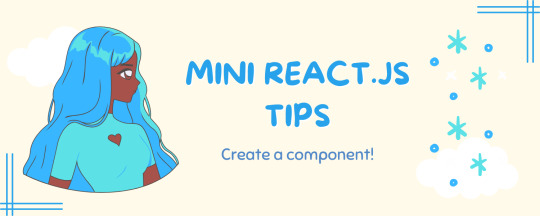
Continuing the #mini react tips series, its components making time~!
In React, a component is like a Lego brick for building websites or apps. It's a small, independent part of the user interface (UI) that you can reuse whenever you need it. These components can be combined to create bigger and more complex applications. Examples are the header, footer, cards, asides, etc!
What you'll need:
know how to create a React project >> click
know the default React project's file structure >> click
know basic HTML
know basic JavaScript
basic knowledge of using the Terminal

What We Are Creating:
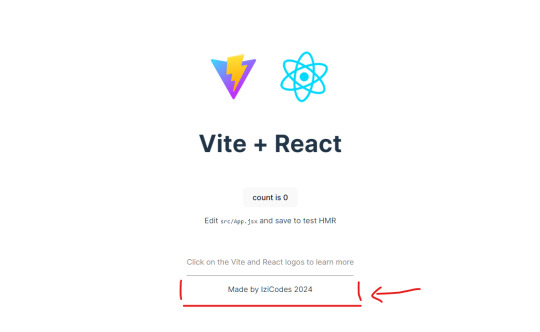
The footer at the bottom!

[ 1 ] Navigate to the 'src' Folder: Open your project in Visual Studio Code, locate the 'src' folder, and right-click on it.
[ 2 ] Create a New File: Click 'New File' to create the file within the 'src' folder. This file will house the code for your React component.
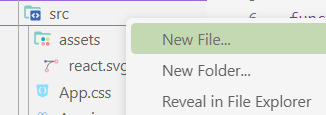
[ 3 ] Naming Conventions: Give your component a name, according to the convention of starting with a capital letter. This naming convention is essential for React to recognize your component~!!
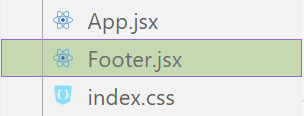
[ 4 ] Create The Initial Function: Open the file and type:
export default function [name of component]() {}

[ 5 ] Insert The return() Statement: The statement is used within a component to specify what content should be rendered when the component is invoked or used. Type:
return()

*the error is there because we haven't added anything inside yet, don't worry!
[ 6 ] Insert The Empty Tags: Inside of the return(), add empty tags (tags that don't have a specified element inside of them).
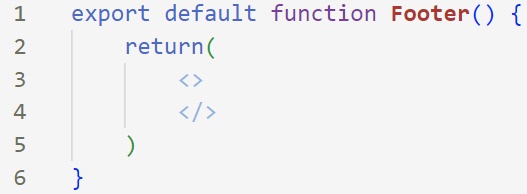
[ 7 ] Time For Some HTML: Inside the empty tags, enter the normal HTML elements that you want~!
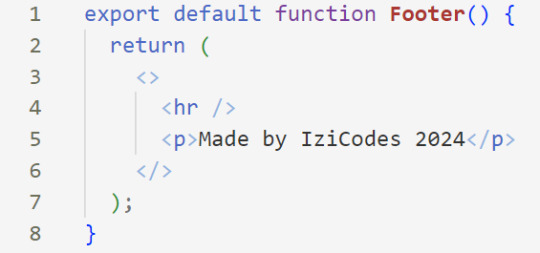
[ 8 ] Integration with App.jsx: Navigate to the 'App.jsx' file in the project, which is typically the entry point of your React application. At the top, import your newly created component. Type:
import [name of component] from './[location of the component]'

[ 9 ] Use Your Component: Inside the return() statement of the 'App()' function, include your component using the following syntax:
<[name of your component] />
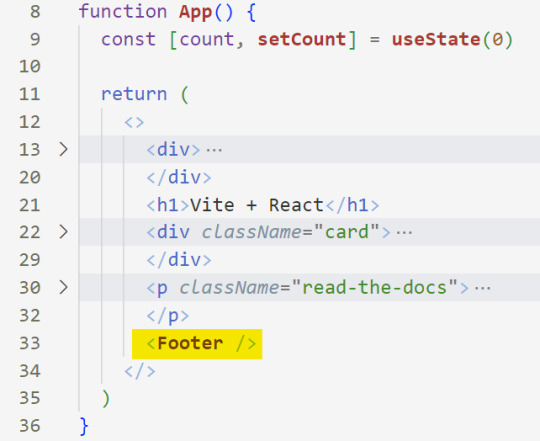
[ 10 ] Run the Development Server: Start your development server with the command (the 'Local' link):
npm run dev
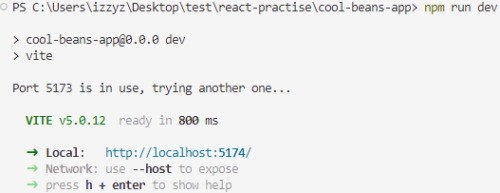
[ 11 ] Preview Your Project: Open the link provided in your terminal in your web browser. Witness your component in action!


Congratulations! You made your first component! Try and create some new ones and place them around in the App()~!
BroCode’s 'React Full Course for Free’ 2024 >> click
React Official Website >> click
W3School's React Components >> click
Importing and Exporting Components >> click
🐬Previous Tip: Tip #2 The anatomy of the default React project >> click
Stay tuned for the other posts I will make on this series #mini react tips~!
#mini react tips#my resources#resources#codeblr#coding#progblr#programming#studyblr#studying#javascript#react.js#reactjs#coding tips#coding resources
33 notes
·
View notes
Text
Technical Aspects of React Native: A Deep Dive
Introduction to React Native
React Native is a popular open-source framework developed by Facebook for building mobile applications using JavaScript and React. It allows developers to create applications for both iOS and Android platforms using a single codebase, making it a cost-effective and time-efficient solution for cross-platform app development.
React Native employs a combination of JavaScript and native components, leveraging the power of React to build dynamic and high-performance mobile applications. In this article, we will explore the technical aspects of React Native, including its architecture, components, performance optimizations, and best practices for development.
Architecture of React Native
React Native's architecture is based on a three-tiered system:
JavaScript Thread: This is where the business logic, UI updates, and interactions occur. The JavaScript code is written using React components and is executed via the JavaScript engine.
Bridge: The bridge serves as a communication link between JavaScript and native modules. It enables bidirectional communication between the JavaScript layer and platform-specific APIs.
Native Thread: The native layer consists of platform-specific components (written in Objective-C, Swift, or Java/Kotlin) that are responsible for rendering UI components and executing device-specific operations.
This architecture enables React Native to offer near-native performance while allowing developers to write most of the application logic in JavaScript.
Core Components of React Native
React Native provides a rich set of built-in components and APIs that enable developers to create seamless and interactive mobile applications. Some of the key components include:
1. View and Text
<View>: Acts as a container for other components and allows layout customization using Flexbox.
<Text>: Used for rendering text elements with various styling properties.
2. Image and ScrollView
<Image>: Displays images from local assets or remote sources.
<ScrollView>: A scrollable container that allows vertical and horizontal scrolling.
3. Touchable Components
<TouchableOpacity>, <TouchableHighlight>, <TouchableWithoutFeedback>: Provide touch feedback and interaction capabilities.
4. Navigation and Routing
React Native does not have a built-in navigation system. However, libraries such as React Navigation and React Native Navigation are commonly used for handling navigation and routing between screens.
5. State Management
State management can be handled using React Context, Redux, or MobX depending on the complexity of the application.
Performance Optimization in React Native
While React Native provides an efficient way to build cross-platform applications, optimizing performance is crucial to ensure a smooth user experience. Here are some key strategies for performance optimization:
1. Optimizing Image Loading
Use react-native-fast-image for optimized image rendering.
Prefer vector images (SVGs) for icons and simple graphics.
2. Reducing Re-Renders
Use React.memo and useCallback to prevent unnecessary component re-renders.
Implement PureComponent for class-based components.
3. Efficient List Rendering
Use FlatList and SectionList instead of ScrollView for large datasets.
Enable windowSize and removeClippedSubviews for performance enhancements.
4. Optimizing Native Modules
Avoid excessive communication between JavaScript and Native modules.
Use the JSC (JavaScriptCore) Engine for better performance.
5. Minimizing Bundle Size
Remove unnecessary dependencies and use Metro bundler optimizations.
Enable Hermes Engine (a lightweight JavaScript engine designed for React Native).
Best Practices for React Native Development
Following best practices ensures maintainability, scalability, and efficiency in React Native applications.
1. Code Structure and Organization
Maintain a modular code structure.
Use feature-based folder organization.
2. Type Safety
Use TypeScript to add static type checking and reduce runtime errors.
3. State Management
Use React Context for simple applications and Redux for complex state management.
4. Error Handling and Debugging
Utilize tools like Reactotron, Flipper, and Sentry for debugging and error monitoring.
5. Security Best Practices
Secure sensitive data using AsyncStorage encryption.
Implement SSL pinning and JWT authentication for secure API interactions.
The Future of React Native
React Native continues to evolve, with upcoming features aimed at improving performance and developer experience. Some of the notable advancements include:
Fabric Renderer: A new rendering engine that reduces bridge overhead and improves UI responsiveness.
TurboModules: Optimized native module interactions for better performance.
Hermes Enhancements: Further improvements to the Hermes JavaScript engine for better efficiency.
These advancements solidify React Native as a powerful framework for mobile development, offering both flexibility and near-native performance.
Why Choose Celadonsoft for React Native Development?
React Native development requires expertise in JavaScript, native modules, and performance optimizations. If you're looking for a trusted partner to build high-quality mobile applications, Celadonsoft offers professional React Native development services tailored to your business needs.
Why Celadonsoft?
Experienced team of React Native developers.
Custom-tailored solutions for cross-platform applications.
Efficient and cost-effective mobile app development.
Continuous support and maintenance services.
With Celadonsoft, you can ensure a seamless development process and a high-performance mobile application. Contact Celadonsoft today to bring your React Native project to life!
Conclusion
React Native has revolutionized mobile app development by enabling cross-platform compatibility without compromising performance. Understanding its architecture, components, and performance optimizations is crucial for building efficient applications. By following best practices and leveraging advanced tools, developers can create scalable and high-performing apps.
For businesses looking to implement React Native, partnering with an expert development team like Celadonsoft can make a significant difference in delivering a successful mobile application. Our React development company offers robust solutions enhancing excellence for your projects.
0 notes
Note
📂!
Send a 📂 (or, just "folder") to hear about a WIP I love but am probably never going to finish writing or an idea I think about a writing lot but am probably never going to get around to. optionally: specify a fandom or character or ship or whatever you're interested in hearing any ideas about
Since I recently moved over all my files from Notion into Obsidian, I have rediscovered by fragments of a Ravening War fic in which Tarthur, whose health is declining, decides to pardon Lucas Fontina, further clearing the name of Colin, who decides to go to Lacramor to accept it against his better judgement.
It was structured that Lucas was the cousin of Tarthur's grandfather, where Lucas was the son of a sister of Tarthur's great-grandfather. So, it was about the fraught family dynamics, and cycles, and the state of the Dairy Isles, between two families that were on the verge of becoming extinct.
Also what it meant to Colin, who does not care for the courts and disdains nobility, to have his grandfather's name cleared but that and family ties draws him into these circles. Snips:
Included was a second document. The paper was cheap, of the sort used for distribution and for reading as proclamation by knights in taverns. The ink bled a little but not so much to ruin legibility. It began, too in Lacra: An Act for Reversing the Attainder of Lucas Fontina. A resolution of the attainment of Lucas Fontina of the Rennetwood of Isle Lacramor was passed by Prince Tristifer Cheddar, Fourth of His Name, Sovereign Ruler of the Dairy Islands, Earl of Lacramor, Warden of the [blah blah] Lucas was imprisoned four days and then executed by pot on account of high treason in the Year of Our Bulb [blah]. By the authority of Prince Tarthur Cheddar, Third of His Name, Sovereign Ruler of the Dairy Islands, Earl of Lacramor, Wavemaster of the Dairy Sea, Defender of the Faith, Lucas Fontina is hereby reinstated in his just credit and reputation.
—
“What matter have you for His Grace?” “I've been summoned by, um, His Grace. I'm Provolone.” The herald nodded curtly in recognition. Faster than Colin could react, they slammed the heel of their staff against the stone floor twice, then shouted, “The Sir Colin Provolone,” the most minute of pauses, then, “Of House Fontina.” Silence settled over the court. [Blah blah blah] Colin stepped forward. “I-I'm not a sir. Not anymore. It's just Colin Provolone. Of House Fontina, sure, yeah. That part's right.” Unfortunately. “I received your summons.” “A prodigal son returns.” Scattered laughter ran around the court. Tarthur didn’t seem to find it funny. “It is unbecoming to be so rude to a cousin of mine, Lord Emment. Especially when I’ve restored his claim to lands that are now yours.” The man muttered some apology. “I-I have no interest in his lands. Don't worry about it.” “I didn't know we were cousins. Nobody told me.”
—
Colin knelt on both knees, as if in prayer. “Not dissimilar from preparing to get my head knocked off,” he joked. “Don't tempt me.” The prince drew his sword. “It would be cleaner than the way they killed my father and grandfather.” Tarthur sighed but said nothing more. He polished the blade with his cloak as he mused on the words. “Colin of House Fontina of the Rennetwood in the Eye, Knight of the Church of Vegetania—” “No longer, my lord.” Tarthur took such a long sigh that Colin did feel briefly bad for aggravating an ill man. “I should know that. I've been sleepless for weeks over you.” “I'm glad to hear it.” Tarthur laughed.
—
The kid from court earlier ran up to them. He took a short bow. “Duchess, your father requests your presence. He wishes to discuss some things before petitions this afternoon.” He nodded to Colin, “You are invited to attend as well, if you wish, my…” He hesitated and trailed off into an uncertain lord. Annabelle snickered and jabbed her elbow into Colin's side. “We need to figure out how to address you. Or not, it's funny watching everyone try to work it out.” Colin ignored her. “If I wish? So, I can just not go?” “Yes. His Grace emphasized that Annabelle is required, but for you, it is your choice.” “Wow, okay. I think I'll not go.” “You think?” Annabelle teased. “I'll not go.”
1 note
·
View note
Text
Build a Simple To-Do List App with React
In this blog post, we will walk you through creating a simple yet functional To-Do List App using React. This application will allow users to add tasks, mark them as complete, and delete them. Let’s get started!

Step 1: Set Up the Project
To begin, set up a new React project. If React is not installed on your system, open your terminal or command prompt and run the following command:
npx create-react-app todo-app
This will create a folder named todo-app containing the React project files. Navigate to this folder and start the development server:
cd todo-app
npm start
Once the server is running, you’ll see the default React page in your browser.
Step 2: Create the To-Do App Structure
Next, let’s build the structure of our To-Do List App. Create a new file named TodoApp.js in the src directory. This file will contain the main React component for our app. Here is the code for the component:
import React, { useState } from 'react';
import './TodoApp.css';
const TodoApp = () => {
const [tasks, setTasks] = useState([]);
const [task, setTask] = useState('');
// Function to add a task
const addTask = () => {
if (task.trim()) {
setTasks([...tasks, { text: task, completed: false }]);
setTask('');
}
};
// Function to delete a task
const deleteTask = (index) => {
setTasks(tasks.filter((_, i) => i !== index));
};
// Function to toggle task completion
const toggleComplete = (index) => {
setTasks(
tasks.map((task, i) =>
i === index ? { ...task, completed: !task.completed } : task
)
);
};
return (
<div className="todo-app">
<h1>To-Do List App</h1>
<div className="input-section">
<input
type="text"
value={task}
onChange={(e) => setTask(e.target.value)}
placeholder="Add a new task"
/>
<button onClick={addTask}>Add Task</button>
</div>
<ul>
{tasks.map((task, index) => (
<li key={index} className={task.completed ? 'completed' : ''}>
<span>{task.text}</span>
<button onClick={() => toggleComplete(index)}>
{task.completed ? 'Undo' : 'Complete'}
</button>
<button onClick={() => deleteTask(index)}>Delete</button>
</li>
))}
</ul>
</div>
);
};
export default TodoApp;
For More Information
Please Visit Our Website :- https://cyberinfomines.com/blog-details/todo-list-app
0 notes
Text
Understanding ASP.NET: Empowering Modern Web Development
A Comprehensive Guide
ASP.NET, developed by Microsoft, is a robust framework designed for building dynamic and scalable web applications. Since its inception, ASP.NET has revolutionized how developers create web solutions, offering a seamless environment for creating websites, web APIs, and microservices. In this blog, we’ll explore ASP.NET’s features, benefits, and why it’s a top choice for developers.
What is ASP.NET?
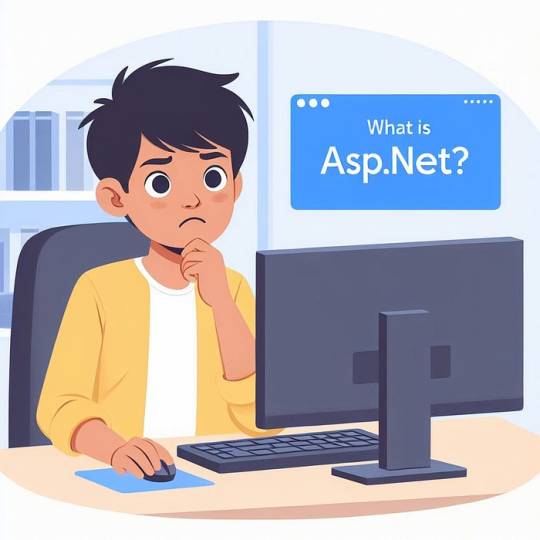
ASP.NET is a free, open-source, server-side web application framework that runs on the .NET platform. It allows developers to create dynamic websites, applications, and services using programming languages like C# and VB.NET. Its modern iteration, ASP.NET Core, is cross-platform, enabling developers to build applications for Windows, macOS, and Linux environments.
Key Features of ASP.NET
High Performance: ASP.NET Core is one of the fastest web frameworks available today. With features like asynchronous programming and efficient request handling, it ensures applications are optimized for speed.
Cross-Platform Compatibility: Unlike its predecessor, ASP.NET Framework, which was restricted to Windows, ASP.NET Core runs seamlessly on Linux, macOS, and Windows, broadening its usability.
Rich Tooling: ASP.NET integrates with Visual Studio, an advanced IDE, offering developers debugging tools, code completion, and templates for faster development.
MVC Architecture: ASP.NET adopts the Model-View-Controller architecture, making it easier to separate concerns, resulting in cleaner and more maintainable code.
Built-In Security: Features like authentication, authorization, and data encryption are integral to ASP.NET, ensuring secure applications by design.
Integration with Front-End Technologies: ASP.NET supports modern front-end frameworks like Angular, React, and Vue.js, allowing developers to create rich user interfaces.
Scalability: ASP.NET is designed to handle high traffic and complex applications efficiently, making it ideal for enterprise-grade solutions.
Advantages of Using ASP.NET
Efficiency: With built-in libraries and support for dependency injection, ASP.NET simplifies the development process.
Versatility: From small websites to large enterprise applications, ASP.NET is suitable for projects of any size.
Community Support: ASP.NET boasts an extensive developer community and rich documentation, making it easier for newcomers to learn and adapt.
Seamless Cloud Integration: ASP.NET works effortlessly with Microsoft Azure, simplifying cloud-based development and deployment.
How to Get Started with ASP.NET
Install the .NET SDK: Visit the official .NET website to download and install the .NET SDK.
Set Up Your Development Environment: Use Visual Studio or Visual Studio Code to create and manage your ASP.NET projects.
Create Your First ASP.NET Project: Run the following command to create a new web application:
dotnet new webapp -o MyFirstApp
4. Run Your Application: Navigate to the project directory and run:
dotnet run
5. Explore and Expand: Dive into the project\u2019s folder structure, experiment with controllers, and learn how to customize views.
Applications of ASP.NET
E-Commerce Websites: ASP.NET’s scalability and security make it an ideal choice for building e-commerce platforms.
Enterprise Applications: With its robust architecture, ASP.NET powers business-critical applications used by organizations worldwide.
Web APIs: ASP.NET is perfect for building RESTful APIs that serve as the backbone for mobile and web applications.
Real-Time Applications: Using SignalR, developers can create real-time applications like chat systems, live dashboards, and notifications.
ASP.NET Framework vs. ASP.NET Core
While the traditional ASP.NET Framework was groundbreaking in its time, ASP.NET Core has taken the framework to new heights. ASP.NET Core is leaner, faster, and cross-platform, making it the preferred choice for new projects. However, the ASP.NET Framework still serves legacy applications and Windows-based systems effectively.
Learning Resources for ASP.NET
For more information about ASP.NET, visit this webpage
This approach makes your content user-friendly by allowing users to click and navigate directly to the resource.
Conclusion
ASP.NET has consistently evolved to meet the demands of modern web development. Its robust feature set, cross-platform capabilities, and seamless integration with cloud technologies make it a go-to framework for developers worldwide. Whether you’re building a personal project or an enterprise-grade application, ASP.NET empowers you to create fast, secure, and scalable solutions. Start your ASP.NET journey today and unlock the potential of this powerful framework!
0 notes
Text
Redesign Planning a Website with New Technology

I can not tell you how many sites I have consulted on where, without a word to the SEM team, the site owner re-launches with a brand new site. Sometimes it's a simple cosmetic change but more often than not its a completely new site with new page naming conventions and new folder hierarchy. In this article I am going to try and explain how you can minimize the impact to your search engine rankings when performing a redesign.
One I'm sure most SEM's are familiar with: You receive a panicked phone call one day from a client. “My rankings are all gone, what have you done? My search engine traffic has dried up and I'm not getting any referrals!” So the first thing I do is go to the site and guess what? It's different than it was just a few days ago. So I ask the client: “When did you do the redesign?” “2 days ago. Why?” “That's the problem. You redesigned without consulting me. You have essentially given the search engine a new website. That means the engine has to re-learn the site and how it works.” Redesign Planning a Website with New Technology. Auto Parts SEO Agency India, Real Estate SEO Agency India, Hotel SEO Company India, Painting web design India.
Mind you I have not had to deal with this is a while, but I remember cases in the past where this has happened. So my first advice to someone planning such a redesign, no matter how minimal, is contact your local SEM or SEO professional and get their opinion. Even a simple re-skinning of your site can have a huge impact on rankings. How can even simple changes affect a site's rankings?
Let me explain why: First, let's look at Google. Earlier this year, they released a patent that basically illustrates how much “smarter” Google will be. But in making itself smarter, Google is making it harder for site owners to make any changes. Basically any change over a given threshold (and no, no one outside of Google knows what that threshold is) will trigger a review of the site, which means it gets removed, or lowered in the index. You may be OK with a 5% or 10% total change site wide, but anything over that will likely trigger such a review.
Because engines like Google ca not “see” the site, they have to compare the HTML to earlier cached versions to see if there's been changes. When Google crawls a site (or page) they assign a calculated value, based on hundreds of elements, to the page. This is a fairly unique computational value, similar to a CRC value.
When Google comes back to request the page again, they perform this same calculation on the page and compare the CRC values. If they are different, they know there's been a change and they need to revisit and re-cache the page. However, if there's been a significant enough change (again breaching that predefined threshold), then Google needs to take a closer look at the page or site. Yahoo! and MSN work similarly, however MSN tends to react a little quicker than Google. When MSN notices a change, the page(s) drop for a few weeks until the new changes are “assimilated” by the engine.
Yahoo! on the other hand, will index the page, however you may not see a change in their results for some time. This is because the engine updates less frequently than Google or MSN. Therefore when Yahoo! does update, your previously cached pages will likely drop and NOT be replaced until the NEXT index update. Your site could drop out of the Yahoo! index for a month or more.
So how to you minimize the impact? First, and I ca not stress this enough, consult with your SEO/SEM consultant. If they tell you there will not be an impact then find another firm, because I can tell you from experience that even the most minor cosmetic changes will impact your site. As such you must prepare for an impact. because it's no longer a matter of it may happen. However by following these simple steps you can minimize the impact. Whenever possible, you should try and keep your old structure and naming conventions. This will help minimize the impact. Even if the page layout and look changes, if the crawlers can find the pages in the same location, this will make the re-indexing happen quicker, restoring the site to its previous rank sooner.
#Redesign#seo marketing#website development#web developers#web development#seo services#digital marketing
0 notes
Text
Pump-Action Summer - A Dixon & Dong Joint
The home on Gonád Road came up in real estate listings as a villa or sometimes a compound. At ground level, a handful of separate structures connected by basements, bridges, and verandas formed a horseshoe around the gardens and swimming pool. The main house stood three stories tall including the attic which opened into a sun room which opened onto a rooftop patio. Somewhere inside were a half-dozen bedroom suites, a commercial-grade kitchen, a private movie theatre, and a highly profitable laboratory. The DiFrodesiac twins knew all this. Their research lay open on their laps as they surveilled the place.
Besides every estate listing, public document, and news clipping for the house going back thirty years, they had manila folders for all four of the occupants, the three members of the Humongous family, as well as their long-time manservant Grone. Jonathan Pritchard Humongous (MS, MSc, PhD) and Adelia Forsythe-Clicks (MA, MSc) were soon to celebrate twenty-eight years of marriage and recently held a party for their daughter Ethel’s twenty-fifth birthday. Ms. Forsythe-Clicks’s architectural firm brought in most of the bacon although Dr. Humongous’s scientific revenue should not be sneezed at. Her buildings drove up rents in every major skyline worldwide, and his patents were the crown jewels of industrial espionage. Ethel Humongous (MS, multiple Bango Award winner) shared some of her father’s patents, held two of her own, and made spectacular erotic cinema. The twins had seen her films and predictably not reacted.
The front door to the house swung sharply open, and Ethel Humongous bounded out. She was evenly caramel-toned from head to foot, with eyes as gold as her hair, and small all over except where it paid better to be large. Her breasts were handsome in the archaic sense, and she had never groomed her thatch. No one had ever asked her to; it was immaculate. She was otherwise physically unremarkable yet utterly superb in terms of personality. No one had ever disliked Ethel except at a distance, and the twins were not far enough away, parked as they were just across the street in their inconspicuous hire car. They both felt an alien stirring in their deficient loins and, with perfect synchronicity, wiggled uncomfortably.
Proximity to Ethel turned a lens on something they’d only understood at an academic level and forced on them personal experience of the prurient, albeit as fleeting as perfume from a passing gondola. What had been a purely mercenary assignment immediately became blood vendetta. The twin riding shotgun turned and reached for the violin case on the back seat, but his brother’s gentle hand on his shoulder stopped him. True, there would be time later for brutale delicto. For now, they still had a tail job to perform, and the DiFrodesiacs were nothing if not dedicated to a good tailing.
Ethel Humongous pulled her sexy little roadster out onto the road, and the twins followed at a professional distance. She led them down the long, empty roads of the suburban hills into downtown California Beach. Traffic thickened. The twins closed the distance of their tail because they could and because they had to. They drove and drove. Ethel stopped at corner stores, clothes shops, delis, and everywhere else up and down the city. She was an easy tail. She obeyed every traffic law and kept a good amount under the speed limit, typical of a youth out to enjoy their salad days in an open-top car in summer, the blue skies overhead and ocean breezes in their hair.
Down along the beachfront, though, she broke the pattern. At a signal turning red from amber, she accelerated hard to beat the light. Ethel’s roadster leapt through the intersection and swung left. The low chassis leaned hard on the right-hand springs as the actor at the wheel pushed the envelope. Both twins felt a surging anxiety. Had she made them? They shared a quick glance that communicated an entire debate. They relaxed. There was no way this bubbly little girl had made them, no chance she was giving them the runaround. They were two of the best. They were focused on their job, unrelenting agents undistracted by carnal trinkets like handjobs or butt stuff. Their perfect record ran longer than that girl had been alive.
The light changed, and they roared around the corner. They scanned the road ahead for their quarry. Surf shacks, convenience stores, taco stands, and taco stands, and taco stands passed by on either side. Every strand of beautiful person seemed to be out and enjoying the day.
Neither twin noticed a sexy little roadster slip into traffic behind them, Ethel Humongous at the wheel, microcamera in hand.
0 notes